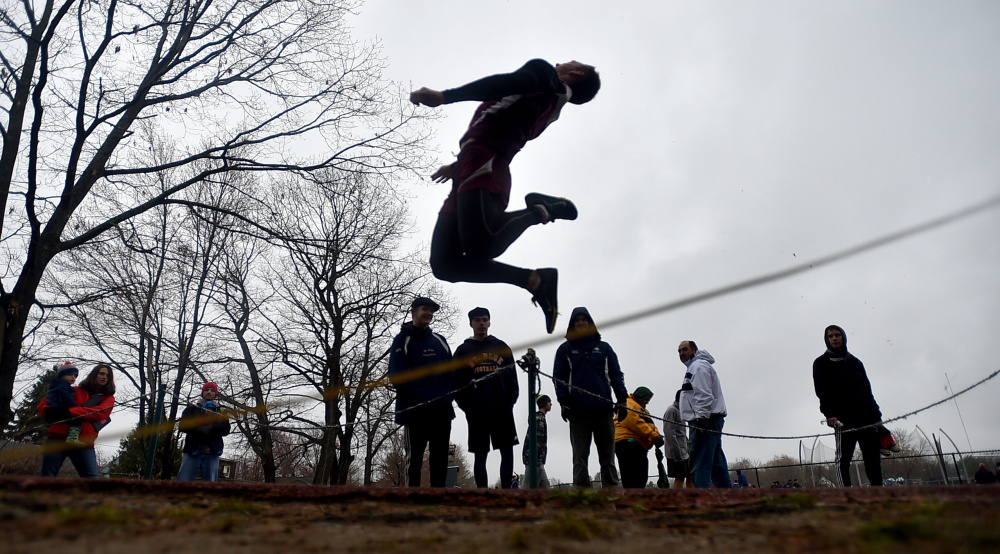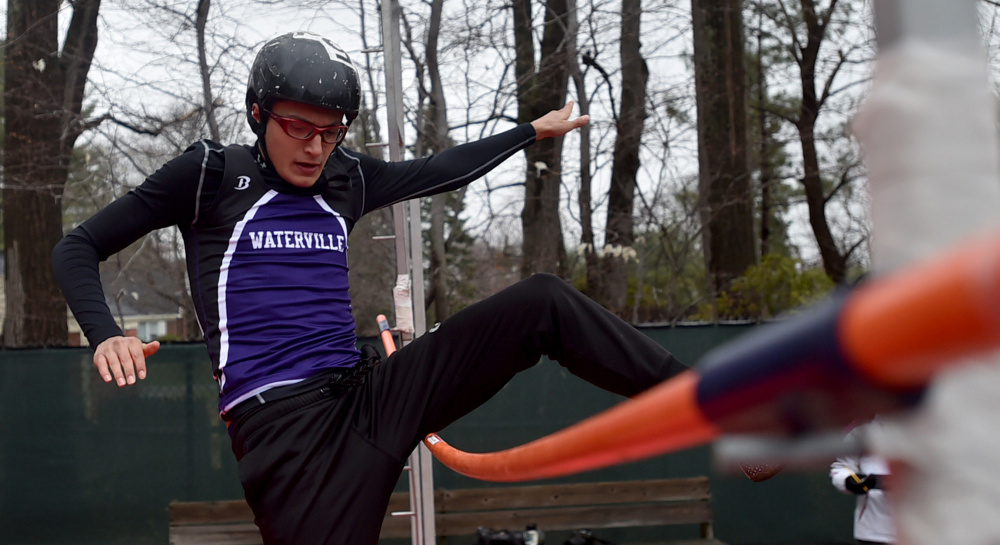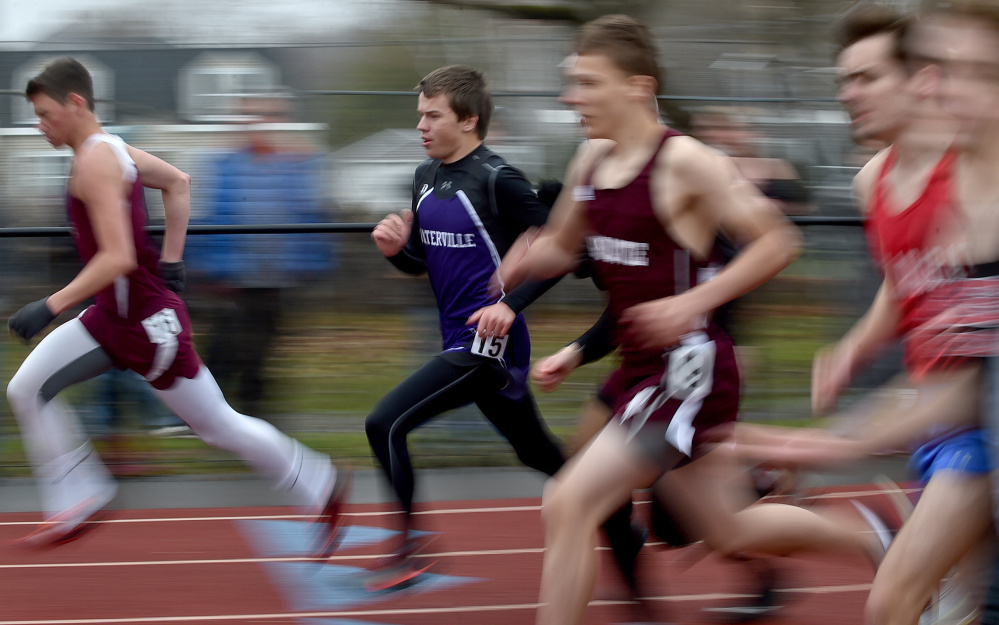WATERVILLE — You wouldn’t have known it watching him run, given the blistering pace with which he tore up the Drummond Field track, but there was a moment when Mt. Ararat’s Eagan Eldridge stood at the starting line for the third leg of the boys distance medley relay, awaiting a baton with 1,200 meters in front of him, that he felt at least a hitch of doubt that it would all go according to plan.
“This was actually the first time I had a handoff with (Kody Noyes),” he said. “I hadn’t done it in practice at all.”
That’s nothing unusual at the Waterville Relays, where there’s a team sense to every event, which can make some of them feel new and unique — and, for creatures of habit track and field athletes, a tad strange. Relays are a staple of the sport, but at Waterville’s early-season meet, the concept is stretched to include disciplines not normally part of the relay mix.
In the field events, places don’t go to the team with the athlete who throws the furthest javelin or discus or jumps the highest or furthest, but to the teams with the best combination of three such performances. It’s the same on the track, where the team with the three best 1,600-meter runs wins the 1,600-meter category. It’s something different, and in a sport without much day-to-day variety, different can be nice.
“It’s just a fun thing, and it does break up the monotony of the regular season,” said coach Jason Allen, whose Maine Central Institute team was one of 10 present, as well as three locals along with Mt. Blue and host Waterville. “A pole-vaulter or triple-jumper is by themselves in the regular season, but here, they’re counting on (each other).”
“We always emphasize ‘team,’ and we want the kids to work together,” Waterville coach Ted Brown said. “Knowing someone is depending on you makes you better.”
Few athletes faced more of an adjustment than the competitors in the medley relays, which had legs of 200, 100, 100 and 400 meters in the sprint relay and 800, 400, 1,200 and 1,600 meters in the distance. After Eldridge took the handoff from Noyes, made up a sizeable gap by passing an Edward Little runner at the end of his first of three circuits and handed the baton to Cameron Meier for what was essentially a mile-long victory lap, he got to congratulate runners with whom he rarely gets to team up. Distance runners and sprinters are normally on their own, but the lines blur at Waterville.
“We rarely run with our 400 runner,” Eldridge said. “It gets guys to work together who usually don’t work together, and then of course you’re invested in everybody to make sure they do exactly what they need to do to get the job done.”
Eldridge also faced the challenge of running the 1,200, an event that doesn’t exist in the normal track and field itinerary. In the girls distance medley relay, Merline Feero got tabbed to run that leg for Waterville, and though the sophomore has traditionally run the mile (1,600) and 2 mile and will run more short events this season, there was no way to acquire a feel for the one-time-only distance.
“It’s a little tough, because the 800 and the 1,600 are very different,” she said. “It’s interesting to try to mix the two, because an 800 is very fast but also short, but a 1,600 is marginally fast but it’s long. So it’s interesting to try to adjust.”
The oddity of the event means teamwork and chemistry, often in short supply at this point in the season anyway, becomes even more rough. Teams practice the relays they’ll need come June, not the ones they need for one Saturday in April, so medley relay teammates had to figure things out on the fly.
“We didn’t know our order until today,” said sophomore Gwinna Remillard, who joined Feero, Odessa Russell and Natalia Fuentes on Waterville’s distance medley squad and ran the 1,600 portion. “If it was a more intense meet, say KVACs or states or something where you could qualify for something else, I would want to practice some more with them. But for just a fun meet like this, it’s fun to just come together and be able to race together.”
Which, for this meet, is the point. Teams have the later weeks of the season to get hyper-competitive about seedings and qualifying times. Right now, this is about seeing what you have, even if that means putting some athletes in an unfamiliar spot.
“We’re always looking for diamonds in the rough,” Brown said. “Kids who think they’re throwers, and all of a sudden, they can run a sprint and they didn’t know it. Or kids that maybe didn’t know they could jump, or distance runners who didn’t know they had any speed.”
And some teams found one — like Mt. Blue, which saw senior sprinter Ian Goding run the 1,600 for the first time in the distance medley, and clear the KVAC meet qualifying time by four seconds in the process.
“Where else can you do that but this meet? You can’t,” Cougars coach Kelley Cullenberg said. “There’s a lot of value, and I think it’s great because it gives the kids the opportunity to discover some other talents that maybe they wouldn’t have the chance to discover otherwise.”
Drew Bonifant — 621-5638
dbonifant@centralmaine.com
Twitter: @dbonifantMTM
Send questions/comments to the editors.






Success. Please wait for the page to reload. If the page does not reload within 5 seconds, please refresh the page.
Enter your email and password to access comments.
Hi, to comment on stories you must . This profile is in addition to your subscription and website login.
Already have a commenting profile? .
Invalid username/password.
Please check your email to confirm and complete your registration.
Only subscribers are eligible to post comments. Please subscribe or login first for digital access. Here’s why.
Use the form below to reset your password. When you've submitted your account email, we will send an email with a reset code.